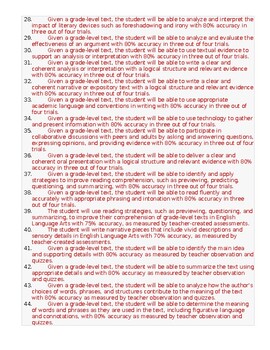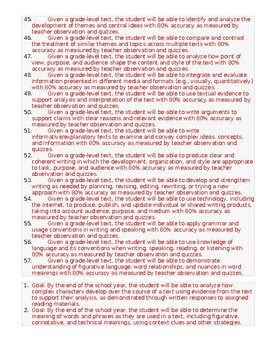ELA IEP Goals 9th Grade-12th Grade
Description
This resource is for teachers or administrators who need a resource to help them write appropriate, relevant, SMART goals for their student's IEP's. This resource is focused on English Language Arts goals.
This resource includes the following:
- Example IEP goal for ELA 9th grade with rationale, accommodations/supports and progress monitoring.
- 9th Grade Goal Bank List (Over 60 9th grade goals related to Next Generation standards, Common Core Standards and considers Danielson Framework)
- Example IEP goal for ELA 10th grade with rationale, accommodations/supports and progress monitoring.
- 10th Grade Goal Bank List (Over 60 10th grade goals related to Next Generation standards, Common Core Standards and considers Danielson Framework)
- Example IEP goal for ELA 11th grade with rationale, accommodations/supports and progress monitoring.
- 11th Grade Goal Bank List (Over 60 11th grade goals related to Next Generation standards, Common Core Standards and considers Danielson Framework)
- Example IEP goal for ELA 12th grade with rationale, accommodations/supports and progress monitoring.
- 12th Grade Goal Bank List (Over 60 12th grade goals related to Next Generation standards, Common Core Standards and considers Danielson Framework)
IEP goals should be individualized because they are designed to address the unique needs of each student. Every student has their own strengths, weaknesses, and learning styles, and an IEP goal that is tailored to their specific needs can help ensure that they receive an education that is appropriate and effective for them.
IEP goals are important because they provide a roadmap for the student's education and help to ensure that they receive the support and accommodations they need to make progress in their learning. They also provide a way for teachers and other school personnel to monitor the student's progress and adjust their instruction and support as needed. IEP goals can help students to stay motivated and engaged in their learning by providing them with achievable targets to work towards, and can help parents and caregivers to understand what their child is working towards and how they can support them at home. Overall, IEP goals are a critical component of a student's education and can help to ensure that they receive the support and resources they need to reach their full potential.
Firstly, ELA skills are crucial for success in many areas of life, including college and career readiness, critical thinking, and effective communication. By setting specific and measurable goals related to ELA skills, students with disabilities can receive the support they need to develop their language and literacy skills and achieve success in these areas.
Secondly, ELA IEP goals are individualized to the student's unique needs and abilities. This means that the goals are tailored to the student's strengths, weaknesses, learning style, and current level of performance. By setting goals that are specific to the student, educators and other professionals can ensure that the student receives the support and accommodations they need to make progress and achieve success.
Lastly, ELA IEP goals help to guide instruction and track progress. By setting specific, measurable, achievable, relevant, and time-bound goals (SMART goals), educators and other professionals can track a student's progress and adjust instruction and interventions as needed to help the student achieve their goals. This helps to ensure that the student is making progress and achieving success in ELA and related areas.





